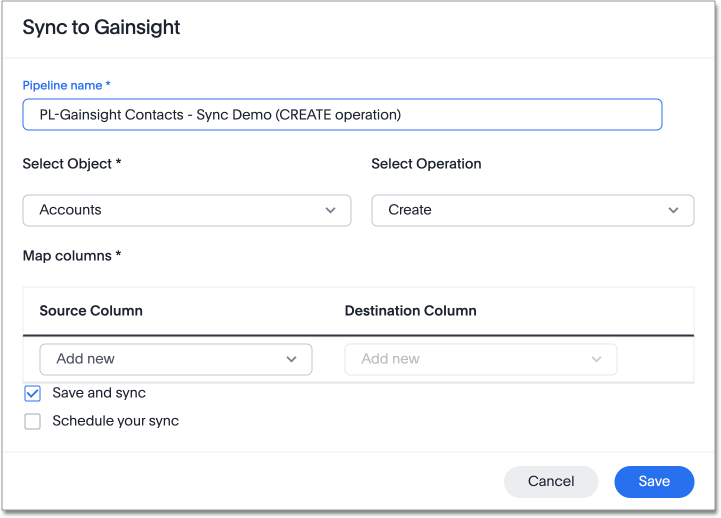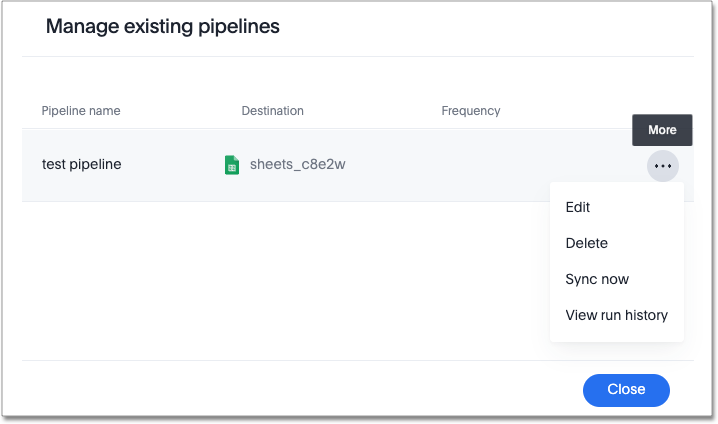Sync data from ThoughtSpot to Gainsight
Prerequisites
Before you create a sync to Gainsight, log in to Gainsight to generate an API key. You need this information to set up your connection. You can generate the API key using the following steps:
-
Log in to Gainsight.
-
Open the menu on the left and scroll down to the Administration section and select REST API under Integrations.
-
Select New API Key in the top right corner.
-
In the pop-up, select the checkboxes under Production Launch. If desired, rename the API key.
-
Click Generate.
-
In the pop-up, click Copy.
Sync to Gainsight from an Answer
To create a sync to Gainsight from an Answer, follow these steps:
-
Select the desired Answer from the Answers tab or the ThoughtSpot homepage. You must have Can manage sync permissions and view access to an Answer to create a sync.
-
In the upper-right corner of the Answer, click the more options menu icon
 . From the dropdown menu, select Sync to other apps, then choose Gainsight.
. From the dropdown menu, select Sync to other apps, then choose Gainsight. -
If this is the first sync you have created for Gainsight, a pop-up authorization window appears. Enter the API key you generated in the prerequisites.
-
Within ThoughtSpot, fill in the following parameters:
-
Edit the Pipeline name if needed. By default, this field populates with PL-[Answer Name].
-
If you have more than one Gainsight destination set up, then the Destination field appears, and you will have to select a Gainsight destination from the dropdown menu available. However, if no destinations have been set up before or if you have only one Gainsight destination, the Destination field will not appear.
-
Select your Gainsight Object from the dropdown menu. You can choose between Accounts and Users.
-
Select Operation from the dropdown menu. You can choose between Create, Update, and Delete.
-
Map the Source and Destination columns from the dropdown menus provided. Note that the Source column refers to the column in ThoughtSpot, while the Destination column refers to the column in Gainsight.

-
-
By default, "Save and sync" is selected. Select Save to send your data to Gainsight. Your data immediately appears in Gainsight.
-
[Optional] To set up a repeated sync, click Schedule your sync and select your timezone. From the options provided, choose whether the sync will occur every:
-
n minutes. You can choose to schedule a sync every 5, 10, 15, 20, 30, or 45 minutes.
-
n hours.
-
n days at a selected time. Note that you can choose not to send an update on weekends.
-
week at a selected time and day.
-
n months at a selected time and date.
-
| Any sync over 50,000 rows may result in an execution timeout. For optimal performance, keep your sync to below 50,000 rows. If you’re syncing a large number of rows and the sync fails, try applying filters like date filters to make your dataset smaller and then sync. |
Sync to Gainsight from a Custom SQL View
To sync to Gainsight from a custom SQL view, follow these steps:
-
Navigate to your SQL view by selecting the Data tab and searching from the Data workspace home page. Select the SQL view name.
-
In the upper-right corner, click the more options menu icon
 and select Sync to Gainsight.
and select Sync to Gainsight. -
If this is the first sync you have created for Gainsight, a pop-up authorization window appears. Enter the API key you generated in the prerequisites.
-
Fill in the following parameters:
-
Edit the Pipeline name if needed. By default, this field populates with PL-[Answer Name].
-
If you have more than one Gainsight destination set up, then the Destination field appears, and you have to select a Gainsight destination from the dropdown menu available. However, if no destinations have been set up before or if you have only one Gainsight destination, the Destination field will not appear.
-
Select Object from the dropdown menu.
-
Select Operation from the dropdown menu. You can choose between Create, Update, and Delete.
-
Map the Source and Destination columns from the dropdown menus provided.
-
-
By default, "Sync and save" is selected. Select Save to send your data to Gainsight. Your data immediately appears in Gainsight.
-
[Optional] To set up a repeated sync, click Schedule your sync and select your timezone. From the options provided, choose whether the sync will occur every:
-
n minutes. You can choose to schedule a sync every 5, 10, 15, 20, 30, or 45 minutes.
-
n hours.
-
n days at a selected time. Note that you can choose not to send an update on weekends.
-
week at a selected time and day.
-
n months at a selected time and date.
-
| Any sync over 50,000 rows may result in an execution timeout. For optimal performance, keep your sync to below 50,000 rows. If you’re syncing a large number of rows and the sync fails, try applying filters like date filters to make your dataset smaller and then sync. |
Sync to Gainsight from the Data workspace
To create a sync to Gainsight from the Data workspace, follow these steps:
-
Select the Data tab.
-
On the left menu bar, select Sync.
-
Under the Pipelines tab, select "Create new pipeline". Note that if you do not already have a destination created to the intended destination app, you first need to create one in the Destinations tab, and authenticate using the API key you generated in the prerequisites.
-
Fill in the following parameters:
-
Edit the Pipeline name if needed. By default, this field populates with PL-[Answer Name].
-
All destinations available appear in the Destination dropdown menu.
-
Select your Source data. Here you will pick an Answer or a custom SQL view to send through sync.
-
Select Object from the dropdown menu.
-
Select Operation from the dropdown menu. You can choose between Create, Update, and Delete
-
Map the source and destination columns from the dropdown menus provided.
-
-
By default, Save and sync is selected. Select Save to send your data to Gainsight. Your data immediately appears in Gainsight.
-
[Optional] To set up a repeated sync, click Schedule your sync and select your timezone. From the options provided, choose whether the sync will occur every:
-
n minutes. You can choose to schedule a sync every 5, 10, 15, 20, 30, or 45 minutes.
-
n hours.
-
n days at a selected time. Note that you can choose not to send an update on weekends.
-
week at a selected time and day.
-
n months at a selected time and date.
-
| Any sync over 50,000 rows may result in an execution timeout. For optimal performance, keep your sync to below 50,000 rows. If you’re syncing a large number of rows and the sync fails, try applying filters like date filters to make your dataset smaller and then sync. |
Manage pipelines
While you can also manage a pipeline from the Pipelines tab in the Data workspace, accessing the Manage pipelines option from an Answer or view displays all pipelines local to that specific data object. To manage a pipeline from an Answer or view, follow these steps:
-
Click the more options menu icon
 and select Manage pipelines.
and select Manage pipelines. -
Scroll to the name of your pipeline from the list that appears. Next to the pipeline name, select the more options icon
 . From the list that appears, select:
. From the list that appears, select:-
Edit to edit the pipeline’s properties. For example, for a pipeline to Google Sheets, you can edit the pipeline name, file name, sheet name, or cell number. Note that you cannot edit the source or destination of a pipeline.
-
Delete to permanently delete the pipeline.
-
Sync now to sync your Answer or view to the designated destination.
-
View run history to see the pipeline’s Activity log in the Data workspace.

-
Related information



